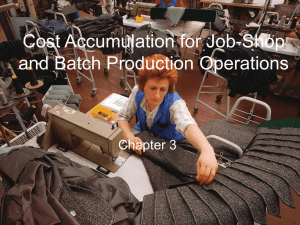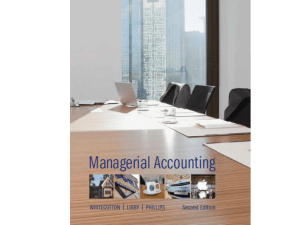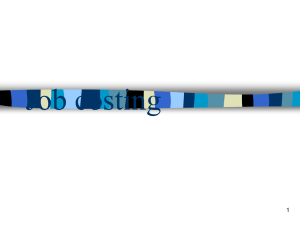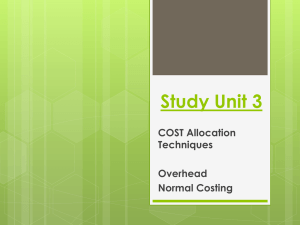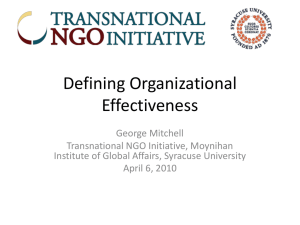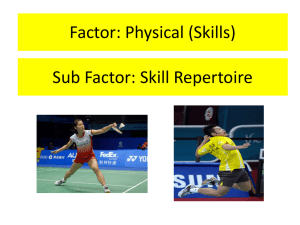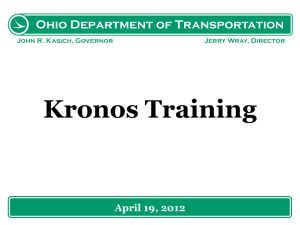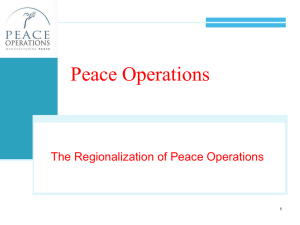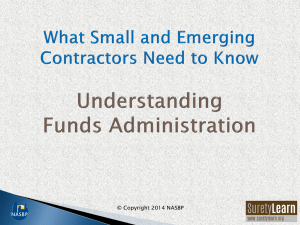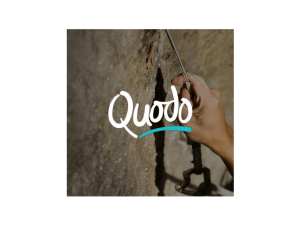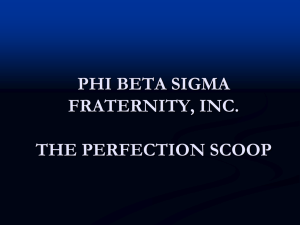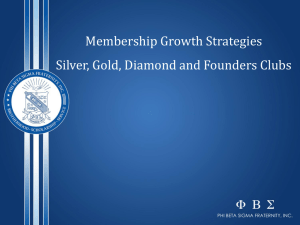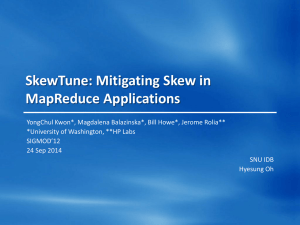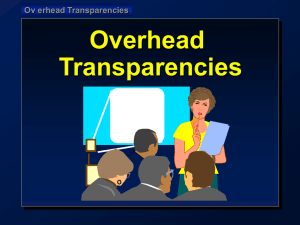Job Order Costing - Marketing Club UMT
advertisement
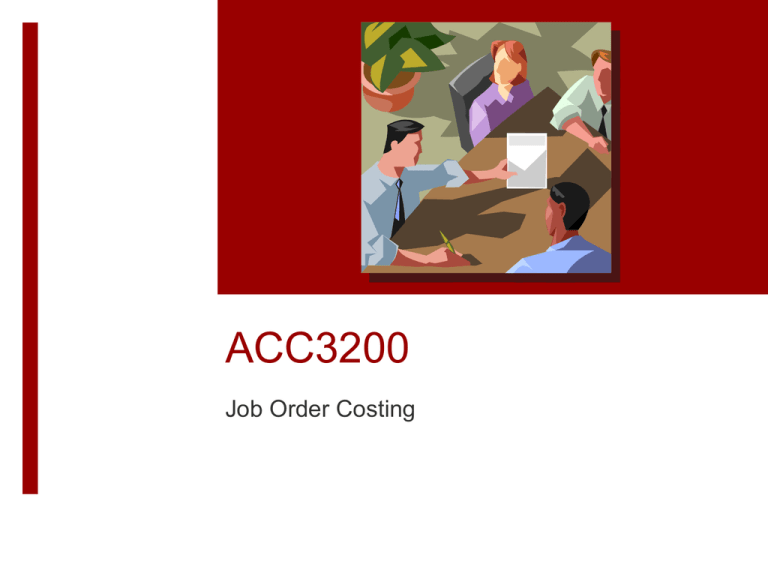
ACC3200 Job Order Costing Learning Objectives Describe the key differences between job order costing and process costing. Describe the source documents used to track direct material and indirect labor costs to the job cost sheet. Calculate a predetermined overhead rate and use it to apply manufacturing overhead cost to jobs. Describe how costs flow through the accounting system in job order costing. Calculate the cost of goods manufactured and cost of goods sold. 2-3 Job Order versus Process Costing Job Order Costing versus Process Costing Description Type of product Manufacturing approach Job Order Costing Unique products and services, such as a custom-built ship. Customized to the needs of the customer or client Cost accumulation Major cost report Costs accumulated by job or customer Job cost sheet for each unique unit, customer, or job Process Costing Homogeneous products and services, such as cans of soda Mass-production of products in series of standardized processes Costs accumulated by process Production report for each major production process 2-4 Process Costing Average Unit Cost = Costs are traced to the process and then divided by units produced to obtain an average unit cost. 2-5 Manufacturing Cost Categories 2-6 Assignment of Manufacturing Costs to Jobs 2-7 Materials Requisition Form 2-8 Direct Labor Time Tickets 2-9 Job Cost Sheet 2-10 Predetermined Overhead Rates Manufacturing overhead is applied to jobs that are in process. An allocation base, such as direct labor hours, direct labor dollars, or machine hours, is used to assign manufacturing overhead to individual jobs. We use an allocation base to apply manufacturing overhead because: 1. It is impossible or difficult to trace overhead costs to particular jobs. 2-11 Predetermined Overhead Rates The predetermined overhead rate (POHR) used to apply overhead to jobs is determined before the period begins using estimates. Predetermined Overhead Rate = Ideally, the allocation base is a cost driver that causes overhead. 2-12 Predetermined Overhead Rates Because home building is a labor intensive business, Toll Brothers uses direct labor hours as the overhead allocation base. Toll Brothers estimates the total manufacturing overhead cost for the year to be $750,000, while direct labor hours are estimated to be 10,000. What is Toll Brothers predetermined overhead rate? POHR = POHR = For each direct labor hour worked on a job, $75.00 of manufacturing overhead will be applied to the job. 2-13 Predetermined Overhead Rates Based on estimates, and determined before the period begins. Predetermined Overhead Rate × Actual Value of the Allocation Base for Each Job = Overhead Applied to an Individual Job Actual amount of the cost driver such as units produced, direct labor hours, or machine hours incurred during the period. 2-14 Predetermined Overhead Rates Predetermined Overhead Rate × Actual Direct Labor Hours for Job #2719 = Overhead Applied to Job #2719 2-15 Predetermined Overhead Rates 2-16 Recording the Flow of Costs in Job Order Costing 2-17 Recording the Purchase and Issue of Materials Toll Brothers purchased $150,000 in raw materials on account. Toll Brothers withdraws $150,000 worth of materials from inventory, $100,000 for Job #2719 (Simpson home), $40,000 for Job #3335 (Flintstone Home) and $10,000 for supplies. Raw Materials Inventory Purchases 150,000 Issued to production 150,000 Manufacturing Overhead 10,000 Work in Process Inventory 140,000 2-18 Recording Labor Costs Toll Brothers incurs $55,000 in labor costs, $30,000 for Job #2719 (Simpson home), $20,000 for Job #3335 (Flintstone Home) and $5,000 for indirect labor. Manufacturing Overhead 5,000 Work in Process Inventory 50,000 2-19 Recording Actual Manufacturing Overhead In addition to indirect materials and indirect labor, Toll Brothers incurs other manufacturing overhead costs including: • Salary paid to construction site supervisor, $12,000. • Salary owed to a construction engineer, $8,000. • Property taxes owed but not yet paid, $6,000. • Expired insurance premium for construction, $4,000. • Depreciation on construction equipment, $18,000. Manufacturing Overhead Actual Applied Indirect materials 10,000 Indirect labor 5,000 2-20 Recording Applied Manufacturing Overhead Toll Brothers applies manufacturing overhead to jobs using a predetermined overhead rate of $75 per direct labor hour. Time tickets for the month show a total of 800 direct labor hours, 600 hours for Job #2719 (Simpson home) and 200 hours for Job #3335 (Flintstone Home). Direct Overhead Applied Job # Labor Hrs Rate Overhead Simpson home 2719 600 $ 75 $ 45,000 Flintstone home 3335 200 75 15,000 Total direct labor hours 800 $ 60,000 2-21 Recording Actual and Applied Manufacturing Overhead Manufacturing Overhead Actual Applied Indirect materials 10,000 Applied OH 60,000 Indirect labor 5,000 Supervisor salary 12,000 Engineer salary 8,000 Property taxes 6,000 Insurance expense 4,000 Depreciation 18,000 Work in Process Inventory 60,000 Actual Applied = MOH MOH The difference is closed to cost of goods sold. / 2-22 Transferring Costs to Finished Goods Inventory and Cost of Goods Sold Summary section of job cost sheet for Job #2719 after all costs are updated. Direct material Direct labor Applied MOH Balance Work in Process Inventory 140,000 Job 2719 completed 50,000 60,000 75,000 175,000 Finished Goods Inventory Cost of goods completed 175,000 2-23 Transferring Costs to Finished Goods Inventory and Cost of Goods Sold Assume Job 3719, the Simpson home was sold. Finished Goods Inventory Cost of goods completed 175,000 When job is sold Job 2719 sold Cost of Goods Sold 175,000 175,000 2-24 Recording Nonmanufacturing Costs In addition to manufacturing costs, Toll Brothers incurs non-manufacturing overhead costs. 1. Commissions to sales agent, $20,000. 2. Advertising expense, $5,000. 3. Depreciation on office equipment, $6,000. 4. Other selling and administrative expenses, $4,000. These non-manufacturing costs would be recorded in individual expense accounts, including commission expense, advertising expense, depreciation expense, and other expenses. The total of the selling and administrative expense would be subtracted from gross margin on the income statement. 2-25 Calculating Overapplied and Underapplied Overhead Actual Applied Indirect materials 10,000 Applied OH 60,000 Indirect labor 5,000 Supervisor salary 12,000 Engineer salary 8,000 Property taxes 6,000 Insurance expense 4,000 Depreciation 18,000 Balance 3,000 2-26 Disposing of Overapplied and Underapplied Overhead The most common method for disposing of the balance in Manufacturing Overhead is to make a direct adjustment to Cost of Goods Sold. Overapplied Manufacturing Overhead (credit balance) Decreases Cost of Goods Sold Underapplied Manufacturing Overhead (debit balance) Increases Cost of Goods Sold 2-27 Summary of Recorded Manufacturing and Nonmanufacturing Costs 2-28 Cost of Goods Manufactured Report Toll Brothers Cost of Goods Manufactured Report Beginning raw materials inventory $ Plus: Raw material purchases Less: Indirect materials Less: Ending raw materials inventory Direct materials used Direct labor Manufacturing overhead applied Total current manufacturing costs Plus: Beginning work in process inventory Less: Ending work in process inventory Cost of goods manufactured 150,000 (10,000) 140,000 50,000 60,000 250,000 (75,000) 175,000 2-29 Cost of Goods Manufactured Report Toll Brothers Income Statement Sales revenue Cost of goods sold Beginning finished goods inventory $ Plus: Cost of goods manufactured 175,000 Less: Ending finished goods inventory Unadjusted cost of goods sold 175,000 Plus: Underapplied manufacturing overhead 3,000 Gross profit Selling and administrative expenses Net income from operations $ 275,000 $ 178,000 97,000 35,000 62,000 Supplement Journal Entries for Job Order Costing 2-31 Recording the Purchase and Issue of Materials Toll Brothers purchased $150,000 of raw materials on account. Accounts Raw Materials Inventory Debit Credit 150,000 Accounts Payable 150,000 The company issued $100,000 of raw materials to Job 2719 and $40,000 to Job 3335. Indirect material of $10,000 were issued. Accounts Debit Credit 2-32 Recording Labor Costs The following labor costs were incurred during the period. Direct labor on Job 2719 $ 30,000 Direct labor on Job 3335 20,000 Indirect labor 5,000 Total $ 55,000 Accounts Debit Credit 2-33 Recording Actual Manufacturing Overhead The following overhead costs were incurred during the period. Manufacturing Overhead Actual Applied Supervisor salary 12,000 Engineer salary 8,000 Property taxes 6,000 Insurance expense 4,000 Depreciation 18,000 Accounts Debit Credit 2-34 Recording Applied Manufacturing Overhead Here is how we applied overhead during the period. Direct Overhead Applied Job # Labor Hrs Rate Overhead Simpson home 2719 600 $ 75 $ 45,000 Flintstone home 3335 200 75 15,000 Total direct labor hours 800 $ 60,000 Accounts Debit Credit 2-35 Transferring Costs to Finished Goods Inventory and Cost of Goods Sold. Job 2719, the Simpson home, was completed at a cost of $175,000. Accounts Finished Goods Inventory Debit Credit 175,000 Work in Process Inventory 175,000 The Simpson home was purchased for $275,000 cash. Accounts Debit Credit 2-36 Recording Nonmanufacturing Costs Toll Brothers incurs non-manufacturing overhead costs. 1. Commissions to sales agent, $20,000. 2. Advertising expense, $5,000. 3. Depreciation on office equipment, $6,000. 4. Other selling and administrative expenses, $4,000. Accounts Commission Expense Debit 20,000 Commissions Payable Advertising Expense Prepaid Advertising Credit 20,000 5,000 5,000 2-37 Overapplied or Underapplied Manufacturing Overhead At the end of the period, Toll Brothers has a $3,000 debit balance in the Manufacturing Overhead account (underapplied overhead). Accounts Debit Credit End of Topic 5

